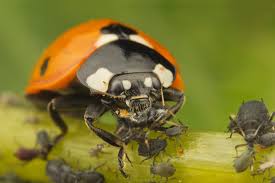Transplants can cost four or five dollars a plant, which means that in one growing season you’ll make back your investment in seed starting equipment . To grow strong, healthy seedlings you need a seed starting tray
. To grow strong, healthy seedlings you need a seed starting tray , a heating mat
, a heating mat (to keep the soil warm and discourage damping off fungus), and a light
(to keep the soil warm and discourage damping off fungus), and a light source. It really does make a huge difference in plant vigor when seedlings get plenty of strong overhead light, rather than weak sunshine coming through a window.
source. It really does make a huge difference in plant vigor when seedlings get plenty of strong overhead light, rather than weak sunshine coming through a window.
You will also want a light soil , good for starting seeds.
, good for starting seeds.
You will also want a light soil
Radishes are one of the easiest cool weather vegetables to grow, and don’t require starting indoors. Watermelon
are one of the easiest cool weather vegetables to grow, and don’t require starting indoors. Watermelon is a tasty and beautiful variety, adding color to spring salads. You can “winter sow” cilantro
is a tasty and beautiful variety, adding color to spring salads. You can “winter sow” cilantro seeds now wherever you have room in a sunny border or vegetable and they’ll sprout when it’s warm enough to grow. Lacinato Kale
seeds now wherever you have room in a sunny border or vegetable and they’ll sprout when it’s warm enough to grow. Lacinato Kale is a nutritious, easy to grow green that is at home in the flower border as well as the vegetable garden. You’ll have the best luck if you start this indoors.
is a nutritious, easy to grow green that is at home in the flower border as well as the vegetable garden. You’ll have the best luck if you start this indoors.
Seedling Heat Mats prompt seeds to germinate and grow faster and ideal for starting seeds indoors.
prompt seeds to germinate and grow faster and ideal for starting seeds indoors.
Basil
Sow Seed Indoors
Basil
Sow Seed Indoors
Apr-8
Sow Seed or
Transplant Outdoors
May-27
Bean s
s
Sow Seed Outdoors
May-27
Beets
Sow Seed Outdoors
Apr-29
Broccoli
Sow Seed Indoors
Feb-25
Sow Seed or
Transplant Outdoors
Apr-15
Brussels Sprouts
Transplant Outdoors
Apr-15
Cabbage
Sow Seed Indoors
Feb-25
Sow Seed Outdoors
Apr-15
Transplant Outdoors
Apr-22
Carrots
Sow Seed Outdoors
Apr-22
Cauliflower
Sow Seed Indoors
Mar-11
Sow Seed or
Transplant Outdoors
Apr-15
Celery
Sow Seed Indoors
Mar-15
Sow Seed or
Transplant Outdoors
May-6
Collards
Sow Seed Indoors
Apr-15
Sow Seed Outdoors
Apr-15
Transplant Outdoors
Apr-22
Corn
Sow Seed Outdoors
May-20
Cucumber
Sow Seed Indoors
Mar-25
Sow Seed or
Transplant Outdoors
May-27
Eggplant
Sow Seed Indoors
Apr-1
Sow Seed Outdoors
May-27
Transplant Outdoors
Jun-3
Kale
Sow Seed Outdoors
Apr-15
Transplant Outdoors
Apr-22
Kohlrabi
Sow Seed or
Transplant Outdoors
Apr-22
Leek
Sow Seed Outdoors
Apr-29
Lettuce
Sow Seed Indoors
Apr-1
Sow Seed or
Transplant Outdoors
Apr-22
Melons
Sow Seed Indoors
May-20
Sow Seed or
Transplant Outdoors
Jun-3
Okra
Sow Seed or
Transplant Outdoors
Jun-17
Onions
Sow Seed Indoors
Mar-15
Sow Seed or
Transplant Outdoors
Apr-22
Parsley
Sow Seed Indoors
Feb-25
Sow Seed or
Transplant Outdoors
Apr-15
Peas
Sow Seed Outdoors
Apr-8
Pepper s
s
Sow Seed Indoors
Apr-1
Sow Seed or
Transplant Outdoors
Jun-3
Potatoes
Sow Seed Outdoors
Apr-22
Pumpkins
Sow Seed Indoors
May-6
Sow Seed or
Transplant Outdoors
Jun-3
Radish
Sow Seed Outdoors
Apr-22
Squash, Summer
Sow Seed Indoors
May-6
Sow Seed Outdoors
May-20
Transplant Outdoors
May-27
Squash, Winter
Sow Seed Indoors
May-20
Sow Seed or
Transplant Outdoors
Jun-3
Sweet Peas
Sow Seed Outdoors
Apr-22
Sweet Potatoes
Sow Seed Outdoors
May-27
Swiss Chard
Sow Seed Indoors
Mar-25
Sow Seed Outdoors
Apr-29
Tomatoe s
s
Sow Seed Indoors
Apr-8
Sow Seed or
Transplant Outdoors
May-27
Turnip
Sow Seed Outdoors
Mar-25
Sow Seed or
Transplant Outdoors
May-27
Bean
Sow Seed Outdoors
May-27
Beets
Sow Seed Outdoors
Apr-29
Broccoli
Sow Seed Indoors
Feb-25
Sow Seed or
Transplant Outdoors
Apr-15
Brussels Sprouts
Transplant Outdoors
Apr-15
Cabbage
Sow Seed Indoors
Feb-25
Sow Seed Outdoors
Apr-15
Transplant Outdoors
Apr-22
Carrots
Sow Seed Outdoors
Apr-22
Cauliflower
Sow Seed Indoors
Mar-11
Sow Seed or
Transplant Outdoors
Apr-15
Celery
Sow Seed Indoors
Mar-15
Sow Seed or
Transplant Outdoors
May-6
Collards
Sow Seed Indoors
Apr-15
Sow Seed Outdoors
Apr-15
Transplant Outdoors
Apr-22
Corn
Sow Seed Outdoors
May-20
Cucumber
Sow Seed Indoors
Mar-25
Sow Seed or
Transplant Outdoors
May-27
Eggplant
Sow Seed Indoors
Apr-1
Sow Seed Outdoors
May-27
Transplant Outdoors
Jun-3
Kale
Sow Seed Outdoors
Apr-15
Transplant Outdoors
Apr-22
Kohlrabi
Sow Seed or
Transplant Outdoors
Apr-22
Leek
Sow Seed Outdoors
Apr-29
Lettuce
Sow Seed Indoors
Apr-1
Sow Seed or
Transplant Outdoors
Apr-22
Melons
Sow Seed Indoors
May-20
Sow Seed or
Transplant Outdoors
Jun-3
Okra
Sow Seed or
Transplant Outdoors
Jun-17
Onions
Sow Seed Indoors
Mar-15
Sow Seed or
Transplant Outdoors
Apr-22
Parsley
Sow Seed Indoors
Feb-25
Sow Seed or
Transplant Outdoors
Apr-15
Peas
Sow Seed Outdoors
Apr-8
Pepper
Sow Seed Indoors
Apr-1
Sow Seed or
Transplant Outdoors
Jun-3
Potatoes
Sow Seed Outdoors
Apr-22
Pumpkins
Sow Seed Indoors
May-6
Sow Seed or
Transplant Outdoors
Jun-3
Radish
Sow Seed Outdoors
Apr-22
Squash, Summer
Sow Seed Indoors
May-6
Sow Seed Outdoors
May-20
Transplant Outdoors
May-27
Squash, Winter
Sow Seed Indoors
May-20
Sow Seed or
Transplant Outdoors
Jun-3
Sweet Peas
Sow Seed Outdoors
Apr-22
Sweet Potatoes
Sow Seed Outdoors
May-27
Swiss Chard
Sow Seed Indoors
Mar-25
Sow Seed Outdoors
Apr-29
Tomatoe
Sow Seed Indoors
Apr-8
Sow Seed or
Transplant Outdoors
May-27
Turnip
Sow Seed Outdoors
Mar-25




